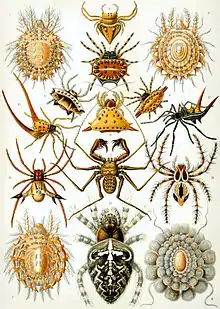< Dichotomous Key
 "Arachnida" from Ernst Haeckel's Kunstformen der Natur, 1904 |
|
Arachnids are the largest and most well known class of the Chelicerata with around 65,000 described species. Members of Arachnida can be found on every continent. There are 11 subgroups that most authorities recognize, but the level of classification and some names are not always agrees upon.
Key to the Orders of Arachnida
1
3
- Scorpiones: Opisthosoma ending in a sting; First pair of legs not greatly elongated.
- 4: Opisthosoma not ending in a sting; First pair of legs longer than other pairs.
4
- Palpigradi: Pedipalps similar in size to legs; Less than 5 millimeters in length.
- 5: Pedipalps usually much stouter than legs; Usually larger than 5 millimeters in length.
5
- Uropygi: Eyes present; Tail long and with many segments; Body blackish and at least 50 millimeters in length.
- Schizomida: Eyes absent; Tail short with one to four segments; Body brownish to yellowish and less than 8 millimeters in length.
6
- Pseudoscorpiones: Pedipalps pincerlike; Body more or less oval and flattened; Usually less than 5 millimeters in length.
- 7: Pedipalps leglike or different, but not pincerlike.
7
- Solifugae: Chelicerae very large and extending forward; Body yellow to brownish and 20 to 30 millimeters in length.
- 8: With different combination of characters.
8
9
- Schizomida: Prosoma longer than wide; Opisthosoma with a minute terminal appendage; 5 to 8 millimeters in length.
- Amblypygi: Prosoma wider than long; Opisthosoma without a minute terminal appendage; Body length variable.
10
- Ricinulei: Broad flap at anterior end of prosoma concealing chelicerae; Legs not unusually long; Somewhat mite-like or tick-like.
- Opiliones: Broad flap covering chelicerae absent; Legs often very long and slender.
This article is issued from Wikibooks. The text is licensed under Creative Commons - Attribution - Sharealike. Additional terms may apply for the media files.